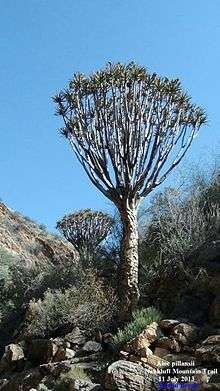Aloidendron pillansii
Aloidendron pillansii, formerly Aloe pillansii, the giant quiver tree or bastard quiver tree, is a large, branching species of succulent plant indigenous to southern Africa. It is regarded as critically endangered.
| Aloidendron pillansii | |
|---|---|
 | |
| Scientific classification | |
| Kingdom: | Plantae |
| Clade: | Tracheophytes |
| Clade: | Angiosperms |
| Clade: | Monocots |
| Order: | Asparagales |
| Family: | Asphodelaceae |
| Subfamily: | Asphodeloideae |
| Tribe: | Aloeae |
| Genus: | Aloidendron |
| Species: | A. pillansii |
| Binomial name | |
| Aloidendron pillansii | |
| Synonyms[1] | |
| |
Description
Aloidendron pillansii grows up to 15 m in height. It branches dichotomously, and superficially resembles Aloidendron dichotomum. It can be distinguished by its paler, wider, recurved leaves, and its taller, more sparsely branched growth form.
Its round, bright yellow flowers are pendant, and hang down below the rosette (unlike those of the other tree aloes). They appear in Spring.
Distribution
It is found around the border between Namibia and South Africa, where its natural habitat is upper mountain slopes, in the arid winter-rainfall Richtersveld shrubland. It is severely threatened by habitat loss, illegal collecting, and livestock grazing.
Cultivation
It rarely appears in cultivation, as it is an extremely slow growing species, and difficult to cultivate.
It requires full sun, extremely well-drained rocky mineral soil, and very dry conditions. In habitat, it grows on rocky slopes in a desert region which receives its sparse rainfall predominantly in the winter.
| Wikimedia Commons has media related to Aloe pillansii. |
References
- "Aloidendron pillansii". World Checklist of Selected Plant Families. Royal Botanic Gardens, Kew. Retrieved 2017-10-16.
- Hilton-Taylor, C. 1998. Aloe pillansii. 2006 IUCN Red List of Threatened Species. Downloaded 20 August 2007.
- "Bastard quiver tree". ARKive. Archived from the original on 2009-06-17. Retrieved 2010-02-13.
- "Aloe pillansii". Namibian Biodiversity Database. Retrieved 2010-02-13.
- "Aloe pillansii". Desert plants. Retrieved 2010-02-13.
- "Aloe pillansii". Be-Amazed Gardening. Archived from the original on 2009-08-11. Retrieved 2010-02-13.
- "Aloe pillansii". The Cactus and succulent plant mall. Archived from the original on 7 February 2010. Retrieved 2010-02-13.
- "Aloe pillansii". Succulent Plant Site South Africa. Retrieved 2010-02-13.
